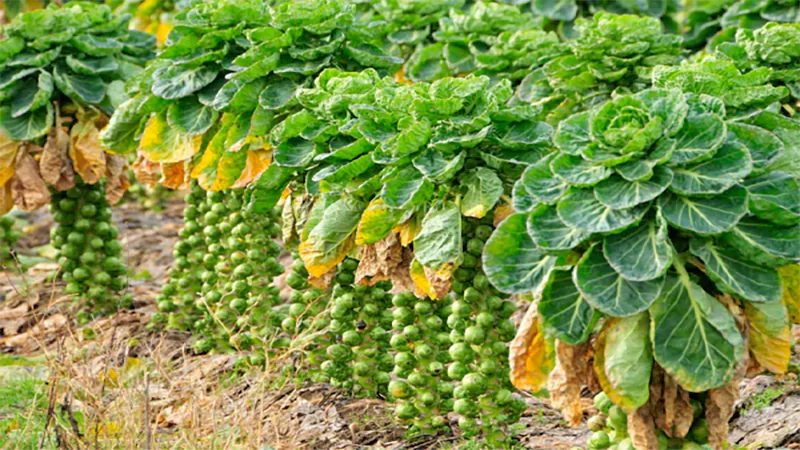Hanging plants are like ornaments that transform the blank walls, empty spaces, and dull corners into lush greenery.
Whether filled with colorful blooms, draped with showy foliage, or displaying unique styles and textures, these drooping beauties enliven the vibe of any place and add liveliness and depth to your landscapes.
These are not just confined to indoor hanging plants, but thrive in your balcony gardens as well as outdoor living areas.
Are you curious to know more about these cascading green gems? Read this article to get a complete idea about its distinct varieties, caring and growing tips, benefits, problems, and fixes.
Hanging Houseplants – Overview & Benefits

To begin with, let’s draw a clear picture: What are Hanging Plants?
Hanging basket houseplants are any plant varieties that can be grown in pots, containers, baskets, or planters that can be placed above the ground surface, be it on the walls, ceilings, doors, railings, or designed holders.
The beauty of these suspended greenery lies in the layers of foliage or blooms that elegantly trail down in unique shapes and patterns. This style of gardening is distinct as it contributes to the aesthetics without taking up the floor space.
Just not restricted to indoor premises, they are a perfect addition to your modern lawns and balconies, transforming your home garden into a minimalistic and effortless style.
Upsides of Hanging Plants
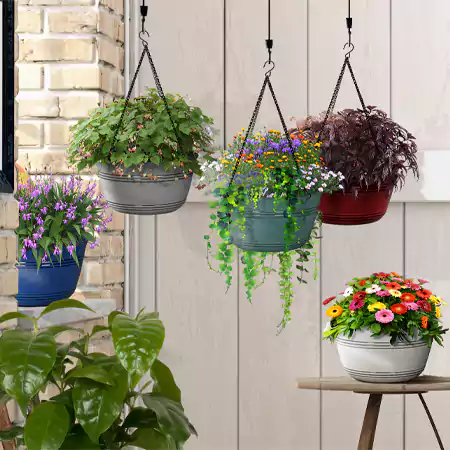
Besides the alluring appeal, trailing baskets offer a myriad of impeccable benefits. More than just being trendy elements, these are smart and stylish ways to decorate the tight spaces with lush beauty.
Let us explore some of the benefits of these overhead greens.
- Space-Savvy Greenery: Ideal for small spaces, apartments, compact patios, balconies, and urban settings where there is limited floor space.
- Improves Air Quality: Many varieties of trailing greens help to improve your home’s air quality by filtering various toxins and pollutants.
A few of them also act as air-purifying bedroom plants by eliminating hazardous elements from the indoor air and replacing them with fresh oxygen.
- Fits into all Types of Interiors: These viney greens complement vintage, Bohemian, modern, or minimalistic settings and elevate the interiors without any major renovation. Plus, it is customisable according to your style, be it for the office, home, or other workplaces.
- Stress Reduction and Relaxation: The presence of lush greenery is beneficial in resolving stress and uplifting mood. It creates a certain vibe filled with tranquility, which gives you a sense of peace.
- Low-Maintenance: Most varieties are easy to care for and thrive in low light conditions. So, even if you do not have hands-on experience with gardening, or if you have but do not have time, you can easily resort to these versatile trailing greens to balance your work with houseplant care.
- Improve Humidity: Basket-grown blooms release moisture naturally into the air, making your in-house environment more comforting, especially in air-conditioned surroundings.
From purifying the air to boosting stress reduction, the health benefits of keeping this plant at home are unlimited, making it one of the most beneficial and appealing outdoor and indoor plants to grow.
Must-Know Factors Before Buying Best Hanging Plants
Selecting the right hanging vining gems is not just about picking visually alluring greens; there are many crucial factors for matching the plant’s needs with the environment.
Take a look at some factors that you need to consider before purchasing these overhead greeneries.
- Light Availability: You have to check if the spot receives ample indirect light and dappled shade because some of them flourish in indirect light and others in partial shade.
- Climate, Temperature, and Humidity: It is essential to sync the plant needs with the indoor temperature and humidity and the outdoor climate for undisturbed growth.
- Growth Habits: Since there are many varieties of trailing greens, like foliage-filled, bloom-filled, or massively spreading ones. Before picking, you have to decide on which type of plant will suit your style and preference.
- Choice of Container: Depending upon your space, area, indoor or outdoor, who has to decide on what containers, whether designed holders, planters, baskets, dangling pots, or lightweight pots that support ceiling hooks are apt for your space, and then choose them accordingly.
- Purpose and Style: One of the most important deciding factors before purchasing the greens is deciding on style and purpose, be it for homes, offices, balconies, entrance, lawn, kitchen, or elevating your boring gardens.
- Maintenance: It is only fair to decide how much time you can dedicate to plant care and then buy accordingly, as some are forgiving, but others need care and attention.
By considering these factors, you can proceed with choosing the species, as plant lovers, you just don’t want to buy them, but also ensure their long-lasting appeal and health.
Explore 15+ Varieties of Hanging House Plants for Every Space
These overhead greeneries come in many forms and varieties, whether hanging indoor plants or outdoors, blooms with vibrant colors, trailing vines, greens with dangling showy foliage, or water-storing succulent leaves.
Here is a list of four main types of outdoor and indoor plants to hang.
Flowering Hanging Plants
Flowering hanging varieties feature cascading foliage with colorful and vibrant blooms. The varieties add a pop of colour and visual interest to your homes, balconies, or outdoor areas.
1. Petunia
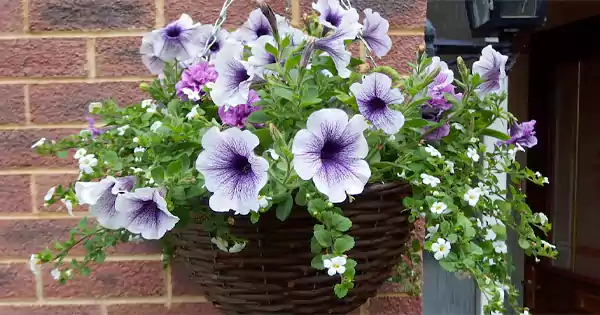
| Category | Details |
| Botanical Name | Petunia x hybrida |
| Hardiness | 9-11 USDA |
| Indoor or Outdoor | Primarily outdoors; it needs ample light to grow indoors |
| Plant Type | Annual flowering plant |
| Features | These are full sun hanging plants with funnel-shaped flowers in various colors that bloom from spring to fall. |
| Light | Thrives in full sun, around 5–6 hours of light daily. |
| Watering | Moderate watering and prefers moist but not soggy soils. |
| Landscape Uses | Hanging baskets, balcony hangings, patio planters, dangling from the ceiling, and garden borders. |
2. Fuchsia
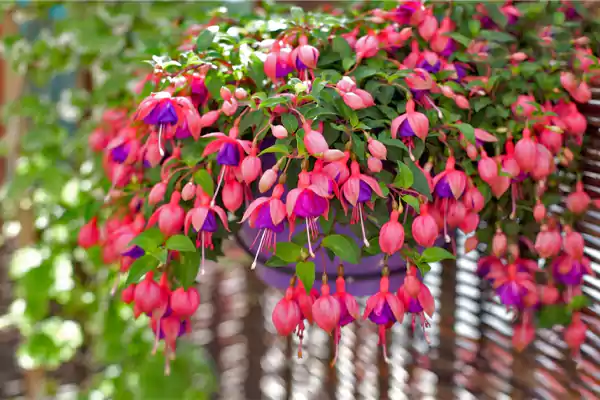
| Category | Details |
| Botanical Name | Fuchsia magellanica |
| Hardiness | 6-11 USDA |
| Indoor or Outdoor | Primarily outdoors; can be shifted indoors during winter |
| Plant Type | Tender perennials |
| Features | Long, bell-shaped flowers and oval leaves with pointed tips, arranged alternately along the stem. |
| Light | Thrives in partial shady conditions. |
| Watering | Tolerates consistent moist soil, but not soggy soil. |
| Landscape Uses | Hanging baskets on patios, balconies, or entrances. |
3. Geranium
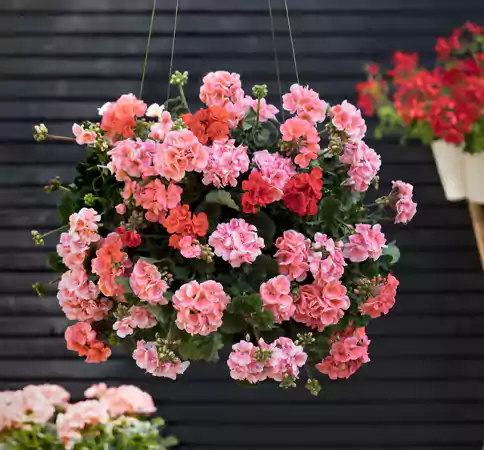
| Category | Details |
| Botanical Name | Pelargonium peltatum |
| Hardiness | 10-11 USDA |
| Indoor or Outdoor | It is suitable for both. |
| Plant Type | Tender perennial |
| Features | Trailing habits, vibrant, long-lasting blooms, and fragrant foliage, drought-tolerant. |
| Light | Thrives in full sun to partial shade. |
| Watering | Water only when the top inch of the soil is dry. |
| Landscape Uses | Hanging baskets, balconies, and bright window corners. |
4. Begonia
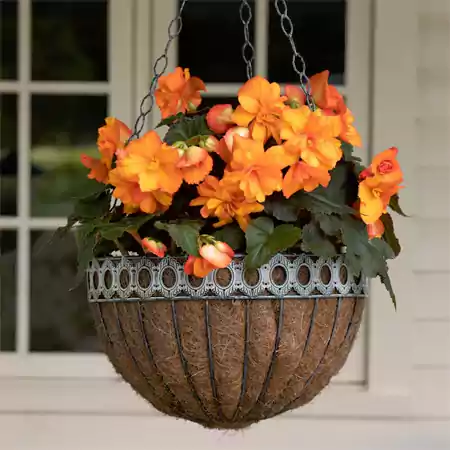
| Category | Details |
| Botanical Name | Begonia x tuberhybrida |
| Hardiness | 9-11 USDA |
| Indoor or Outdoor | Begonia thrives both indoors and outdoors. |
| Plant Type | Tender perennial, but grown as an annual. |
| Features | Large, showy cascading blooms and attractive foliage. |
| Light | Partial to full shade |
| Watering | Water the soil when it seems dry. Overwatering can cause fatal damage to the plant. |
| Landscape Uses | Trailing down in hanging baskets, ideal for patios, balconies, or window boxes. |
5. Impatiens
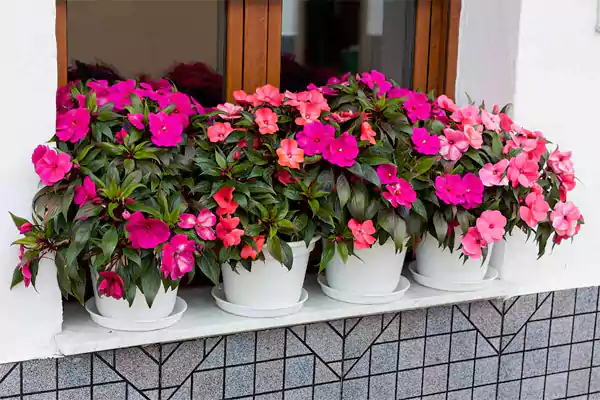
| Category | Details |
| Botanical Name | Impatiens walleriana |
| Hardiness | 10-11 USDA |
| Indoor or Outdoor | Suitable for both indoors and outdoors. |
| Plant Type | Annual flowering plant |
| Features | Bright, vibrant blooms in various colors, shade-loving, and low-maintenance. |
| Light | Partial to full shade |
| Watering | Water to keep the soil regularly moist. Avoid overwatering. |
| Landscape Uses | Ideal for indoor hanging planters, trailing baskets, indoor displays, balconies, shade patios, or designed plant holders. |
Vining Hanging Plants
These varieties are known for their lush, cascading, long stems that are designed to trail downwards or upwards with support. Whether they are spreading down, climbing up, the charm of outdoor or indoor vine plants will give your house a waterfall of greenery.
1. Pothos
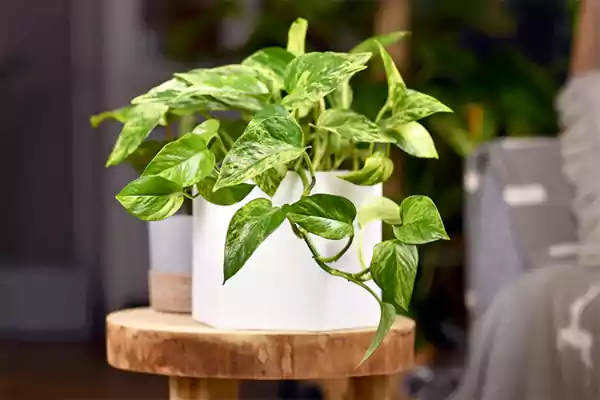
| Category | Details |
| Botanical Name | Epipremnum aureum |
| Hardiness | 10-12 USDA |
| Indoor or Outdoor | Suitable for both indoor and outdoor use. |
| Plant Type | Queen pothos is an evergreen, perennial climbing species. |
| Features | Heart-shaped glossy leaves with pale yellow or white variegations. |
| Light | It’s a low-light hanging plant, and white thrives in indirect light |
| Watering | Water only when the top inches of soil seem dry. |
| Landscape Uses | Dangling baskets, climbers, shelves, indoor spaces with indirect light, balconies, or patios, mixed gardening with other varieties of money plants. |
2. Philodendron
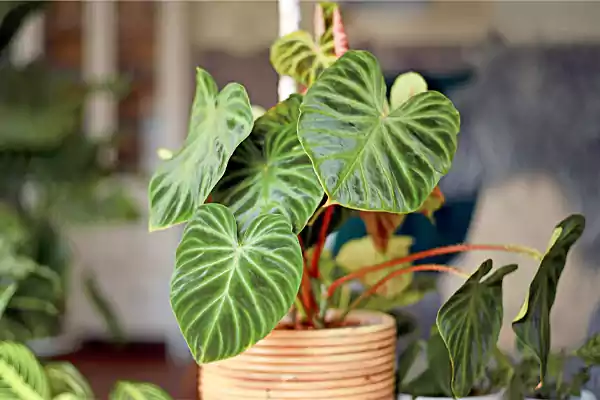
| Category | Details |
| Botanical Name | Philodendron spp. |
| Hardiness | 9-11 USDA |
| Indoor or Outdoor | Philodendron plants are primarily grown indoors due to their sensitivity to cold weather. |
| Plant Type | Evergreen, perennial |
| Features | Many varieties have heart-shaped, glossy leaves with deep red textures, and few varieties have large, lobed leaves. |
| Light | Prefers bright indirect light and can tolerate low-light conditions. |
| Watering | Water when the top few inches of the soil seem dry. |
| Landscape Uses | Trailing baskets, shelves, and indoor spaces, or entrances. |
3. English Ivy
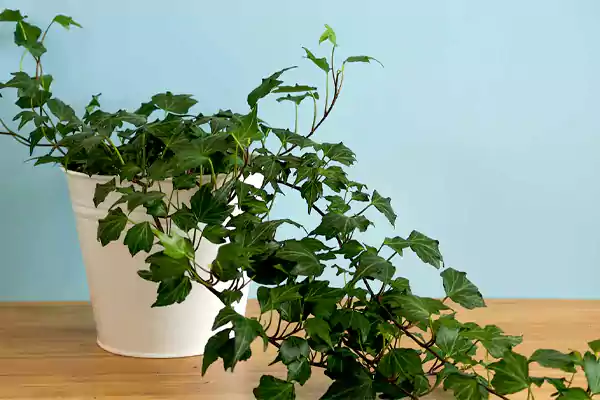
| Category | Details |
| Botanical Name | Hedera helix |
| Hardiness | 4-11 USDA |
| Indoor or Outdoor | It can be grown as a houseplant or an outdoor plant. |
| Plant Type | Evergreen perennial climbing vine. |
| Features | It can spread as ground cover and climb, which makes it useful to cover fences, walls, or structures. |
| Light | Partial to full shade |
| Watering | It thrives in well-drained and most soils, so it’s essential to water regularly, especially during the growing phase. |
| Landscape Uses | Container pots, trailing baskets, groundcovers, wall coverings, or fencing. |
4. String of Pearls
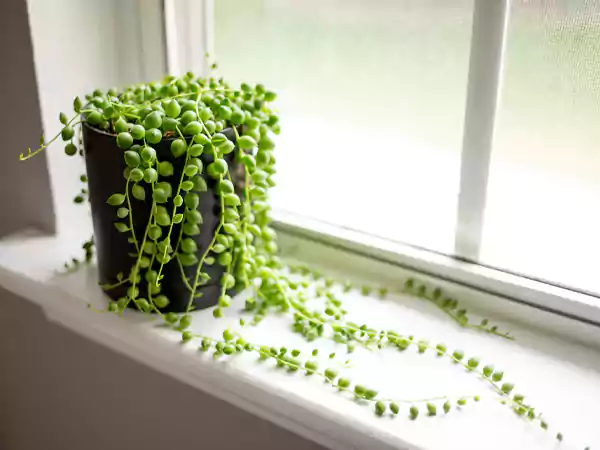
| Category | Details |
| Botanical Name | Senecio rowleyanus |
| Hardiness | 9-11 USDA in the outdoor climate. |
| Indoor or Outdoor | Primarily grown as an indoor plant. |
| Plant Type | Succulent trailing vine |
| Features | Unique spherical pea-like leaves that grow along the slender stems. |
| Light | Bright indirect light is suitable for plant growth. Prevent them from direct, scorching light. |
| Watering | No frequent water is required. Allow the soil to completely dry out between watering sessions. |
| Landscape Uses | Mostly used for trailing baskets that add a distinct appeal to your indoor spaces. |
5. Spider Plants
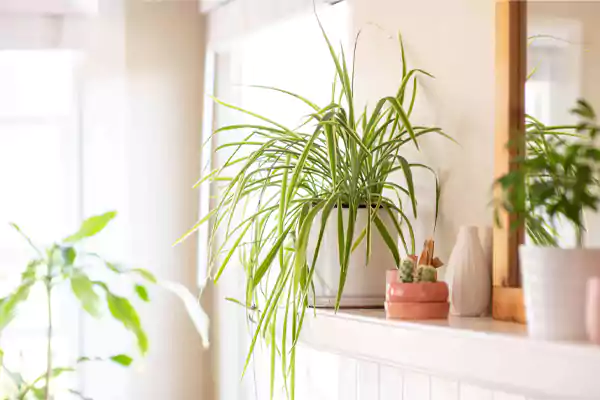
| Category | Details |
| Botanical Name | Chlorophytum comosum |
| Hardiness | 9-11 USDA |
| Indoor or Outdoor | Spider plants can be grown indoors as well as outdoors in shaded areas. |
| Plant Type | Evergreen perennial |
| Features | Features elongated, thin, arching leaves which can be green with some whitish or yellowish variegations. |
| Light | Prefers bright indirect light. |
| Watering | Water them deeply when the soil seems dry. Ensure effective drainage and circulation for best results. |
| Landscape Uses | Mostly used for trailing baskets, container pots, planters, holders, and as groundcovers outdoors. |
Succulent Hanging Plants
Hanging succulents are low-maintenance and extremely easy to care for, and terrarium-friendly plants. These feature trailing stems and vibrant foliage that add to the beauty and visual interest of any place, transforming the ordinary into a green-filled oasis.
1. String of Turtles
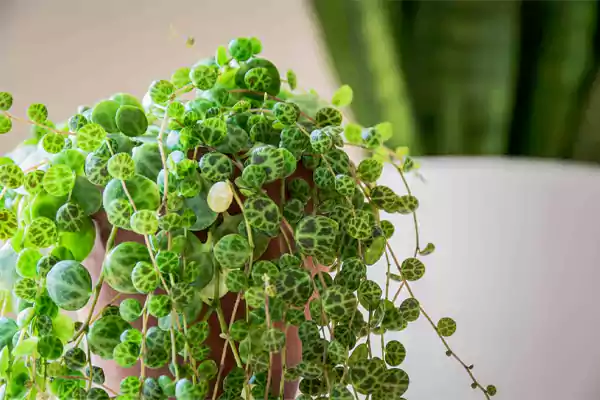
| Category | Details |
| Botanical Name | Peperomia prostrata |
| Hardiness | 10-12 USDA |
| Indoor or Outdoor | String of Turtles is primarily an indoor plant. |
| Plant Type | Succulent trailing vine |
| Features | Delicate, round, small leaves with turtle shell patterns. |
| Light | It thrives in a bright, indirect light indoors. |
| Watering | Water them moderately, allowing the soil to dry between watering sessions. |
| Landscape Uses | Cascading Baskets, tabletops, shelves, terrariums, and small container pots. |
2. Pink Panther Plant
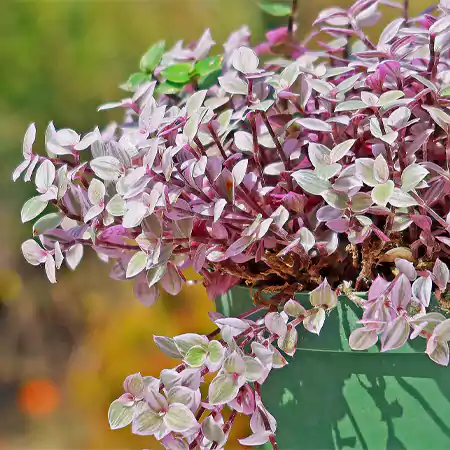
| Category | Details |
| Botanical Name | Callisia repens ‘Pink Panther’ |
| Hardiness | 10-12 USDA |
| Indoor or Outdoor | Primarily grown indoors, but can be moved outdoors in warmer climates. |
| Plant Type | Succulent trailing vine |
| Features | Cascading stems with variegated leaves in pink, green, and cream. |
| Light | Thrives in bright indirect light. |
| Watering | Water when the top one or two inches of the soil seem dry, and avoid overwatering them. |
| Landscape Uses | Trailing baskets, shelf displays, tabletops, terrariums, and small containers |
3. Donkey Tail Plant
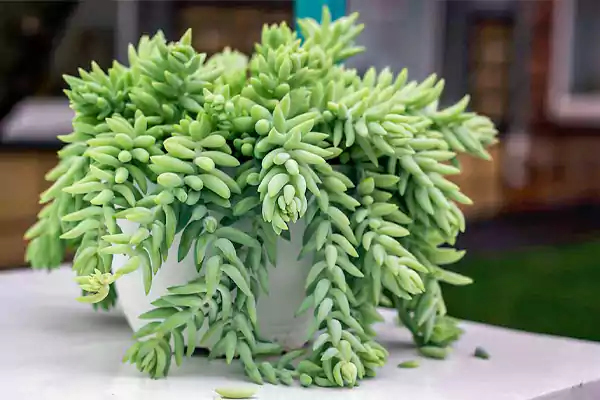
| Category | Details |
| Botanical Name | Sedum morganianum |
| Hardiness | 9-11 USDA |
| Indoor or Outdoor | It can be grown both indoors and outdoors. |
| Plant Type | Succulent perennial |
| Features | Features long trailing stems decorated with plumpy, fleshy, and cylindrical blue-green leaves with a slightly powdery texture. The foliage resembles the tail of a donkey. |
| Light | Thrives best under bright, indirect light. Although it can tolerate full sun, scorching rays can damage the leaves. |
| Watering | Water them moderately, allowing the soil to dry out between watering sessions. |
| Landscape Uses | Trailing baskets, container pots, rock gardens, or groundcovers. |
4. Christmas Cactus
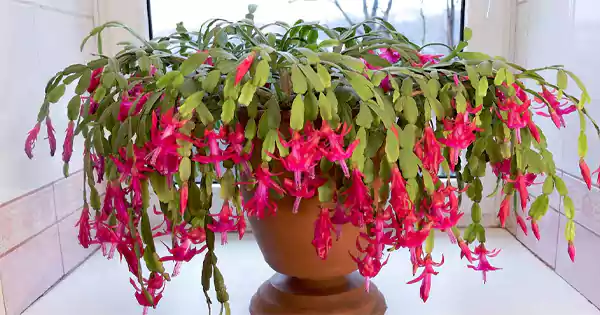
| Category | Details |
| Botanical Name | Schlumbergera bridgesii |
| Hardiness | 10-12 USDA |
| Indoor or Outdoor | Primarily kept indoors and can be shifted outdoors in warmer climates. |
| Plant Type | Succulent perennial |
| Features | It features flat, segmented green leaves and vibrant, bold, beautiful, and blooming flowers in various colors like pink, red, purple, or lavender. Although it belongs to the cactus family, it is not among the types of cactus. |
| Light | Prefers bright indirect light. |
| Watering | Moderate watering needs, only when the soil seems dry. |
| Landscape Uses | Ideal for trailing planters, baskets, tabletops, centrepieces, shelves, or small containers. |
5. Rainbow Bush
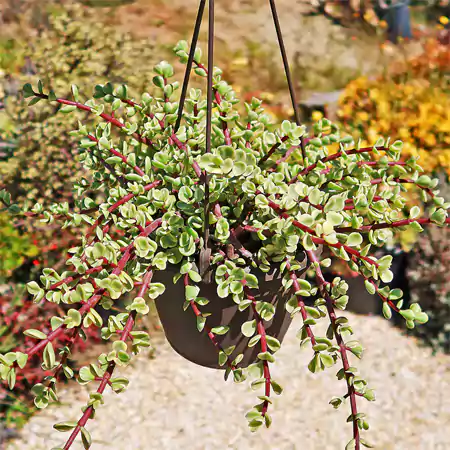
| Category | Details |
| Botanical Name | Portulacaria afra variegata |
| Hardiness | 10-11 |
| Indoor or Outdoor | It can be grown both indoors and outdoors, but it’s best to grow indoors in the dormant season. |
| Plant Type | Shrubby succulent |
| Features | It features green or creamish-yellow variegated leaves with reddish stems. Small lavender-pink flowers appear at the branch tips during late spring. |
| Light | Thrives in bright indirect light to full sun. |
| Watering | Water needs are very low; ensure to water only when the soil dries out completely. |
| Landscape Uses | Its rainbow-like presence makes it fit for edges, trailing baskets, containers, or rock gardens. |
Air Plants & Other Foliage-Focused Hanging Plants
Air plants are more of a foliage-focused green that does not need soil to grow, and are one of the best options for cascading greens. Also known as Tillandsia, these greens absorb water and nutrients through special cells on their leaves.
1. Tillandsia Xerographica
| Category | Details |
| Botanical Name | Tillandsia xerographica |
| Hardiness | 9-11 USDA |
| Indoor or Outdoor | It can be grown both indoors and outdoors. |
| Plant Type | Evergreen perennial & epiphyte |
| Features | Silvery green, wide, curly leaves with reddish bracts and long-lasting red to purple blooms. |
| Light | Prefers bright indirect light. |
| Watering | Occasionally misting or soaking them for 15-20 minutes every few weeks. |
| Landscape Uses | Ideal for shelves, tabletops, containers, patios, and balconies. |
2. Tillandsia Ionantha
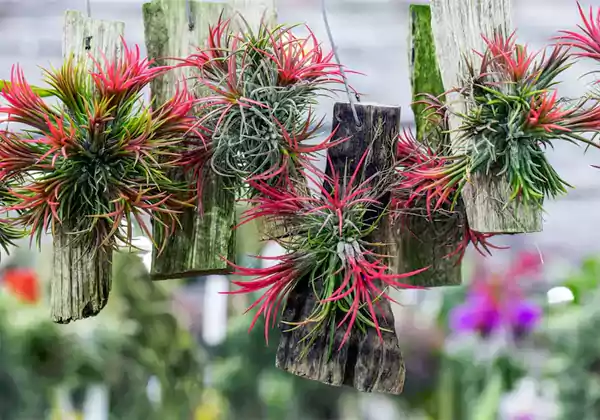
| Category | Details |
| Botanical Name | Tillandsia ionantha |
| Hardiness | 9-11 USDA |
| Indoor or Outdoor | It can be grown as both. |
| Plant Type | Epiphyte |
| Features | Tentacle-like green bracts that change their colour before the flower appears. |
| Light | Bright indirect light |
| Watering | Misting or soaking the plants for 15-20 minutes every few weeks |
| Landscape Uses | Terrariums, trailing baskets, dish gardens, or wall mounts. |
3. Boston Fern
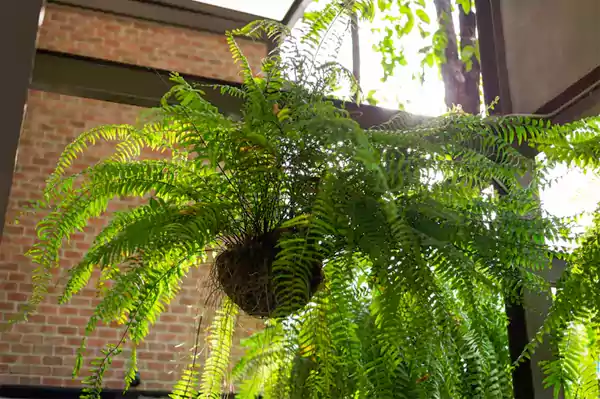
| Category | Details |
| Botanical Name | Nephrolepis exaltata |
| Hardiness | 9-11 USDA |
| Indoor or Outdoor | It is suitable for both. |
| Plant Type | Fern, perennial |
| Features | Blue-green lush feathery fronds and air-purifying qualities. |
| Light | Bright direct light indoors and tolerates partial to full shade outdoors. |
| Watering | Frequent watering benefits the fern, as it needs consistently moist soil. |
| Landscape Uses | Trailing baskets, ground covers, or borders. |
4. Spiderwort
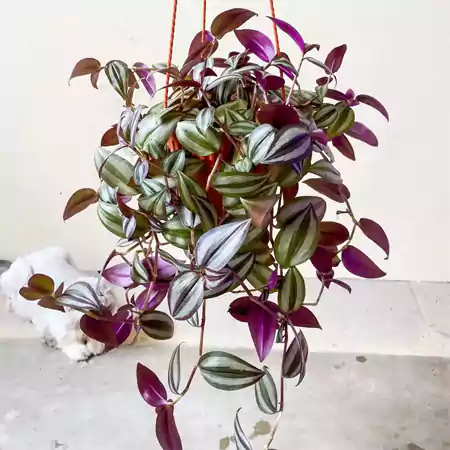
| Category | Details |
| Botanical Name | Tradescantia zebrina |
| Hardiness | 9-12 USDA in warmer regions. |
| Indoor or Outdoor | Primarily grown as a houseplant. |
| Plant Type | Perennial but grown as an annual |
| Features | Zebra-striped leaves with purple undersides. |
| Light | Bright indirect light indoors. |
| Watering | Water when the top few inches of the soil are dry. |
| Landscape Uses | Trailing baskets, shelves, and mixed containers. |
5. String of Bananas
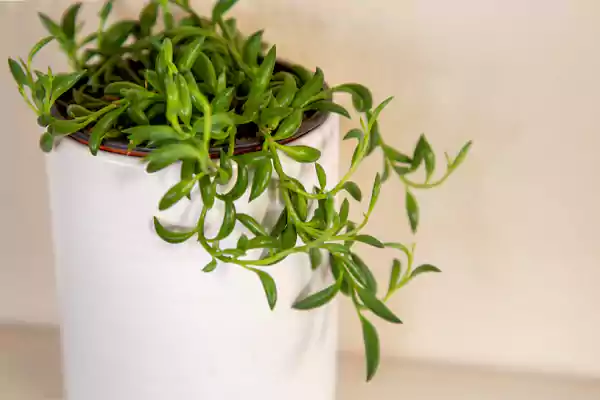
| Category | Details |
| Botanical Name | Curio radicans |
| Hardiness | 9-11 USDA |
| Indoor or Outdoor | Primarily an indoor plant. |
| Plant Type | Succulent |
| Features | Bright green, plump leaves that resemble the shape of a banana. |
| Light | Bright indirect light, but it can tolerate some sun too. |
| Watering | Moderate watering; allow the soil to dry out between watering sessions. |
| Landscape Uses | Trailing baskets, wall mountings, shelves, or succulent gardens. |
Each of these varieties has the trailing and viney characteristics in common, which make them a perfect choice for elevating your homes, offices, outdoor lawns, indoor corners, balconies, and overall decor.
Carrying their charm and inflorescence, these beautiful varieties are hard to ignore and are full of charm and visual appeal, which not only transforms your home into a green oasis but also provides you with an unsaid peace.
How to Grow and Care for Healthy Hanging Plants?
After learning about the alluring varieties, you must be considering bringing one to your home. Although attributed to low maintenance, you must know the minimum conditions and care needs required by these hanging plants indoors or outdoors.
Continue reading to understand the optimal growth and maintenance tips for their lush and vibrant presence.
| Light |
|
| Water |
|
| Soil Type |
|
| Fertilizers |
|
| Pruning |
|
| Rotating |
|
| Pests and Diseases |
|
In addition to the above, they also like their leaves to be dusted off regularly. Accumulation of dust can hinder the growth, so you can prevent this by gently wiping the leaves or spraying water from top to bottom, and allowing them to dry before hanging them again.
By following these care and growth tips, you can create a thriving environment for your hanging plants. With little attention and love, they reward you with lush foliage, flowers, and ineffable charm.
Landscape Designs with Hanging House Plant
There are endless landscape designs with these trailing and climbing plants. Here’s how you can enhance your home’s aesthetics by creating a dream hanging garden.
1. Wall Planters
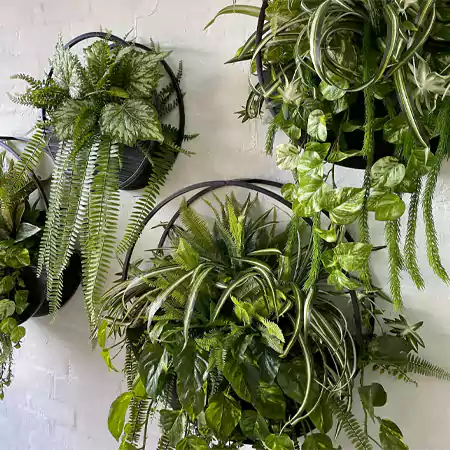
These are the perfect places if you want to uplift your place but don’t have enough space. A spot on your balcony outdoors or a wall near your window in the house can highlight greenery and liveliness.
2. Metal Grills
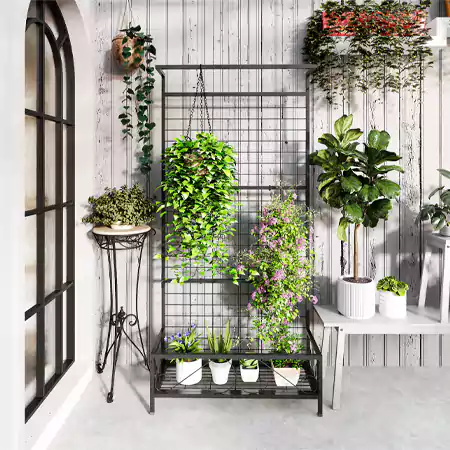
Using metal grills supports the walls by avoiding unnecessary drilling and supports many planters. You can use these plants in metal grills in your balconies or front door for a more minimalistic vibe.
3. Macrame Plant Hanger or Tree Branch
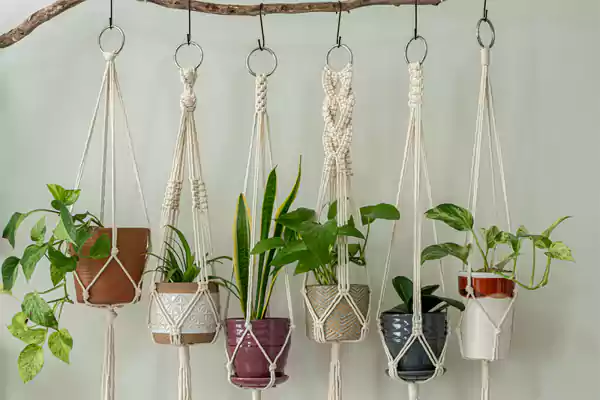
It’s a great way to support your Eclectic or Bohemian home decor. Hang these plants in a macrame plant hanger and create a natural and inviting vibe.
4. Living Curtains
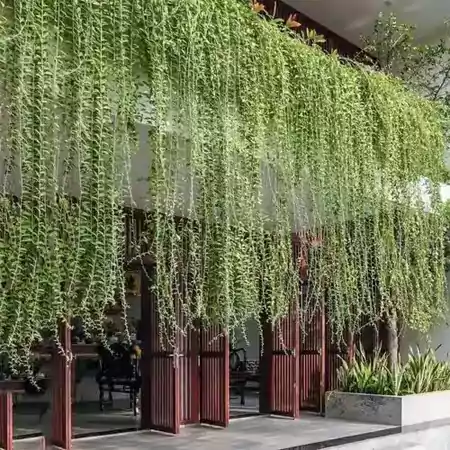
If you have a bare wall or window, you can use these trailing greens to create a natural curtain for a distinct look. Besides, living curtains create an inviting charm, a distinct appeal, and add to the wow element of your ordinary decor.
5. Hanging Terrariums
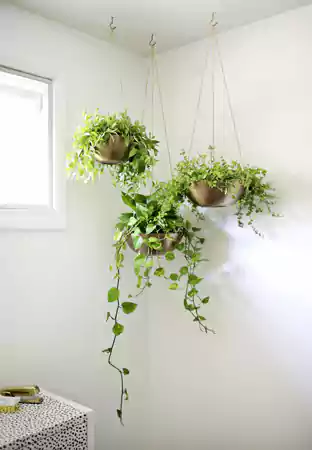
You can use designer containers to cascade the succulent vines either from the walls or from drilled hooks in your balconies and window grills.
6. Tabletops, Shelves, or Patios
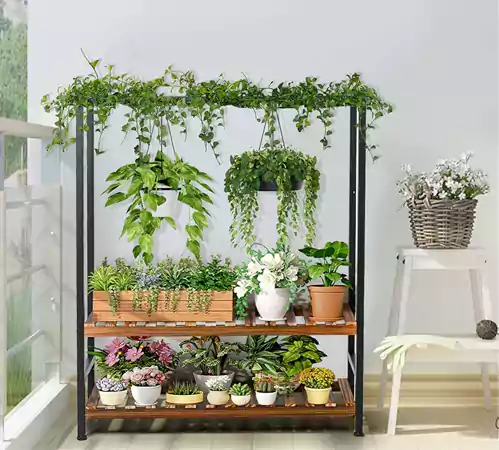
The natural trailing vines of these plants complement the empty spaces and add a great element to your home decor. Be it your table tops, empty shelves, or centrepieces, these dangling beauties are a perfect fit.
7. Wall Trays and Mountings
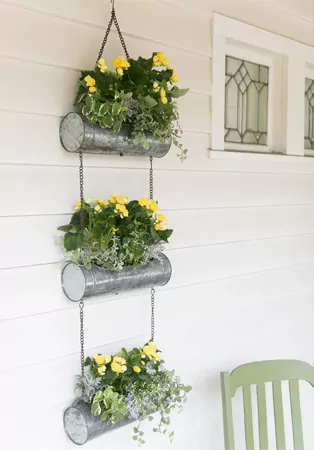
You can use designer wall trays directly mounted on the walls for a more natural look. Be it in your living room, kitchen, balconies, or beside your nameplates, it looks surreal.
Pick your favourite plants and use the following landscaping insights to fill your house with liveliness and aesthetic decor.
Wrapping Up the Hanging Plant Journey
Hanging plants are true examples of nature’s showstopper. They can be your go-to choice for green companions because of their relatively low-maintenance needs and space-savvy attributes.
From being mounted on walls, draped alongside the curtains, dangled from ceilings, or hung from balconies, these versatile overheads truly complement the place with their elegance and charm.
With the help of this article, you can nurture your dream garden with these terrific plants and enjoy the elevated decor and unlimited benefits.
What is the best outdoor trailing plant for winter?
Plants like ivy, pansies, ferns, or primulas are best for winter trailing baskets.
How often should you water hanging plants?
Mostly, these types of plants respond well to watering only after the top few inches of the soil seem dry.
Why are the leaves of my vining plants turning yellow?
Often, the leaves result in discoloration due to under- or overwatering. Finding the right balance is the key to lush growth.
What are the rules of hanging a plant?
The important rules are do not overwater, maintain proper drainage, provide bright indirect light, and ensure good air circulation.
- 15 Best Indoor Hanging Plants – BBC Gardeners’ World Magazine
- Tillandsias as Houseplants – Penn State Extension

